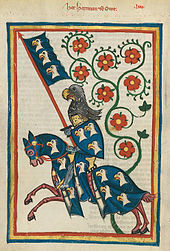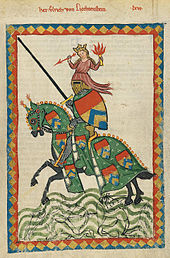Knight
![]()
The title of this article is ambiguous. For other meanings, see Knight (disambiguation).
Knight (Middle High German: rîtære, rîter, riter, ritter, Middle Latin miles, Neo-Latin eques auratus, French chevalier, English knight, Italian cavaliere, Spanish caballero, Polish rycerz, Slavic vitez, vityaz, Hungarian vitéz) is originally the term for the well-armed, heavily armed, mounted warriors of the European Middle Ages.
The Roman "Equites" already represented a socially elevated equestrian class outside of the medieval knighthood discussed here.
From the 11th century onwards, in addition to noble, "noble-free" landlords, non-free court officials (ministerials) established themselves as knights. In the 14th century, their middle and upper classes, who as a rule lived like the old nobility from income from the feudal system, formed the main part of the emerging lower nobility, which now defined itself as the knighthood. The majority of the high and late medieval knights, however, could not establish themselves permanently in the lower nobility of the early modern period for economic reasons. A new sphere of activity for these smaller knightly families was offered by the developing towns. Numerous castle stables in village surroundings and the remains of late medieval fortifications in towns still bear witness to their former existence.
In the later Middle Ages, knighthood, i.e. descent from (lower) noble ancestors ("born to the coat of arms") was usually the prerequisite for attaining knighthood. In a solemn act, originally the Schwertleite, later the Ritterschlag, one was raised to knighthood by the ruler or another noble, provided that one brought the necessary characteristics and qualities. In the end, only about one tenth of those who were actually knights attained knighthood. The remaining members of knight-born families were referred to in Germany as "noble servants", "knaves" (in the common formula "knights and servants"), "squires" or "armigers", among others. In the English-speaking world, knights (Knights) and noble servants (Esquires/Squires) for the late Middle Ages are contemporary and modernly summarized as "men-at-arms".
In the early modern period and until the end of the Holy Roman Empire of the German Nation, recognition as a knight - on the basis of a passed ancestral test - through swearing-in and entry (matriculation) in corresponding nobility registers - in addition to the possession of a so-called knight's estate eligible for parliament - could be decisive for whether there was a right to a seat and vote in parliament or in a cathedral chapter. There were bitterly fought legal disputes about the recognition, such as the "Erbmännerprozess".
In monarchies, sovereign rulers could perform a "Nobilitierung", in the Austrian nobility, the title of knight was also possible here. This privilege was abolished there in 1919 by the Austrian Republic.
The ideal of chivalry and the orders of chivalry still have cultural and social significance today.

Ideal images of high medieval knights: Hartmann von Aue (depicted around 1300)

... and Ulrich of Liechtenstein (Codex Manesse, c. 1340)
Definition
The term knight denotes different aspects depending on the time horizon: a profession especially in the High Middle Ages, a social habitus or a newly accepted noble rank since the Late Middle Ages. Most mounted warriors of the High Middle Ages were not originally considered nobles, but until the 13th century belonged legally to the ministeriality situated between bondage and freedom. The circumstances varied depending on the region.
From the late Middle Ages, the term as a title referred primarily to a special dignity that individual nobles, but also non-nobles, could acquire. Most nobles in the 14th or 15th century did not acquire this knighthood at all. For financial and family reasons, the majority of the lower nobility preferred to be noble servants (Latin armigeri, "shield bearers") for the rest of their lives. In contemporary armies of the late Middle Ages, they made up as much as ninety percent of the mounted warriors. Thus they also belonged to the elite of contemporary armies and were hardly distinguishable from the title-bearing knights in terms of weaponry and tactics. When the term knight is used today to refer to the Middle Ages, it is often unclear whether or not the large body of titleless noble knights is included. Even among high nobles, by the way, knighthood was by no means a matter of course. Sometimes it was bought against payment of a considerable sum.
Occasionally, even proven non-noble war servants (i.e. not descended from families of knighthood) were knighted or girded with the sword. These awards, however, were mostly of a symbolic nature, comparable to today's bestowals of orders, for the servants thus decorated usually lacked the necessary financial means to accept the knighthood permanently. Some particularly brave warriors were even knighted several times, but remained noble servants.
Especially in tournaments, a strict distinction was made from the late Middle Ages onwards between knights (in the sense of knighthood) and noble servants. For example, knights were allowed to appear on the tournament field with three horses, servants were only allowed two. Before big battles, many feudal lords tried to strengthen the fighting morale of their troops by granting knighthood to noble servants in larger numbers. For example, the Polish king Władysław II. Jagiełło is said to have conferred knighthood on a thousand of his "Szlachtschitzen" immediately before the battle of Grunwald/Tannenberg. These "promotions" of course also occurred after the battle.

Cavalry armour of Emperor Maximilian I († 1519)
Historical, regional and political origins
The term "knight", derived from germ. ridare (= to ride) resp. ital. cavaliere, occitan. cavalièr, franc. chevalier, from the late Latin caballarius (= rider), refers to the origin of knighthood from the armored riding that developed in late antiquity and the early Middle Ages. Regionally, the origins of medieval chivalry lie in what is now France; "Frankish (French)" chivalry was then transmitted eastward via the Dutch-speaking area. "Knight" is therefore, according to some historians, a loanword from Dutch. From Germany, the culture of chivalry spread far into Eastern Europe, with Bohemia in particular developing a late but all the more impressive form. Even today, Bohemia is the region with the highest density of castles in Europe. The political basis of European chivalry was feudalism. "Knighthood and feudalism belong indissolubly together in their history" (Josef Fleckenstein). In another form of society, chivalry could not have developed in its historical appearance, since it is based on the social elevation of the warrior (also the "official") from the mass of the people. Here we can see clear parallels to the development of noble warrior castes in other cultures, e.g. the samurai in Japan.
Search within the encyclopedia